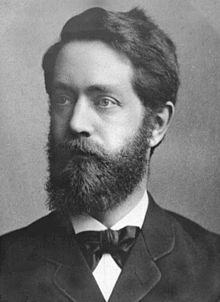Felix Klein
German mathematician, author of the Erlangen Program (1849-1925)
Christian Felix Klein (25 April 1849 – 22 June 1925) was a German mathematician and mathematics educator, known for his work in group theory, complex analysis, non-Euclidean geometry, and on the connections between geometry and group theory.

| This article about a mathematician is a stub. You can help out with Wikiquote by expanding it! |
Quotes
edit- Es ist eine Mannigfaltigkeit und in derselben eine Transformationsgruppe gegeben; man soll die Mannigfaltigkeit angehören Gebilde hinsichtlich solcher Eigenschaften untersuchen; die durch die Transformationen der Gruppe nicht geändert werden. (Given a manifold with its associated transformation group, one should investigate those structures of the manifold that have properties which are invariant under the transformation group.)
- (1893). "Vergleichende Betrachtungen über neuere geometrische Forschungen". Mathematische Annalen 43 (1): 63–100. ISSN 0025-5831. DOI:10.1007/BF01446615. (quote from p. 67)
- This statement is the basis of the Erlangen program.
- The theory of binary forms and the projective geometry of systems of points on a conic are one and the same, i.e., to every proposition concerning binary forms corresponds a proposition concerning such systems of points, and vice versa. ... Elementary plane geometry and the projective investigation of a quadric surface with reference to one of its pointa are one and the same.
- as translated by M. W. Haskell: (1893). "A comparative review of recent researches in geometry". Bulletin of the American Mathematical Society 2 (10): 215-249. (quote from pp. 223–224)
Lectures on Mathematics delivered from Aug. 28 to Sept. 9, 1893 at Northwestern University
edit- In ordinary geometry a surface is conceived as a locus of points; in Lie's geometry it appears as the totality of all the spheres having contact with the surface.
- Lectures on Mathematics. Macmillan & Company for H.S. White and A. Ziwet. 1894. p. 15.
- It has been the final aim of Lie from the beginning to make progress in the theory of differential equations ...
- As regards quartic surfaces, Rohn has investigated an enormous number of special cases; but a complete enumeration he has not reached. Among the special surfaces of the fourth order the Kummer surface with 16 conical points is one of the most important. The models constructed by Plücker in connection with his theory of complexes of lines all represent special cases of the Kummer surface.
- Next to the elementary transcental functions the elliptic functions are usually regarded as the most important. There is, however, another class for which at least equal importance must be claimed on account of their numerous applications in astronomy and mathematical physics; these are the hypergeometric functions, so called owing to their connecton with Gauss's hypergeometric series.
- The proof that π is a transcental number will forerver mark an epoch in mathematical science. It gives the final answer to the problem of squaring the circle and settles this vexed question once for all. This problem requires to derive the number π by a finite number of elementary geometrical processes, i.e. with the use of the ruler and compasses alone.
Quotes about Felix Klein
edit- With Klein, even politics has been introduced into the question: he asserts that “It would seem as if a strong naive space intuition were an attribute of the Teutonic race, while the critical, purely logical sense is more developed in the Latin and Hebrew races.” That such an assertion is not in agreement with facts will appear clearly when we come to examples. It is hardly doubtful that, in stating it, Klein implicitly considers intuition, with its mysterious character, as being superior to the prosaic way of logic and is evidently happy to claim that superiority for his countrymen. We have heard recently of that special kind of ethnography with Nazism: we see that there was already something of this kind in 1893.
- Jacques Hadamard, An essay on the psychology of invention in the mathematical field (1954), pp. 106-107.
- Ehrenfest had always emphasized the importance of Klein's lectures to his students, and we read many of those that circulated in lithograph form. They are full of sweeping insights that reveal the interconnections between different mathematical fields: geometry, function theory, number theory, mechanics, and the internal dialectics of mathematics that manifest themselves through the concept of a group. During my stay in G6ttingen, Courant invited me to help prepare Klein's lectures on the history of nineteenth and early twentieth century mathematics for publication, which I did. These first appeared in Springer's well-known "yellow series," and they remain, with all their personal recollections, the most vivid account of the mathematics of this period.
- Dirk Jan Struik: (1989). "Interview with Dirk Jan Struik by David E. Rowe". The Mathematical Intelligencer 11 (1): 14–26. (quote from p. 19)
- From outside Germany, Klein epitomized the cultured German elite. Self-assured, handsome, highly educated, and married to Hegel's granddaughter, he had all the perquisites of a German professor with a devoted cadre of students. Within Germany, however, there was a split between the school of analysis typified by the great and influential German mathematician Karl Weierstrass, and the proponents of more geometric methods associated with Riemann. Klein had identified himself, and his students, with the latter, and thereby contributed to widening the rift—for Klein's enthusiasm was the sort that divides as much as it unifies.
- Donal O'Shea (30 October 2008). The Poincaré Conjecture: In Search of the Shape of the Universe. Penguin Books Limited. p. 196. ISBN 978-0-14-190034-6.